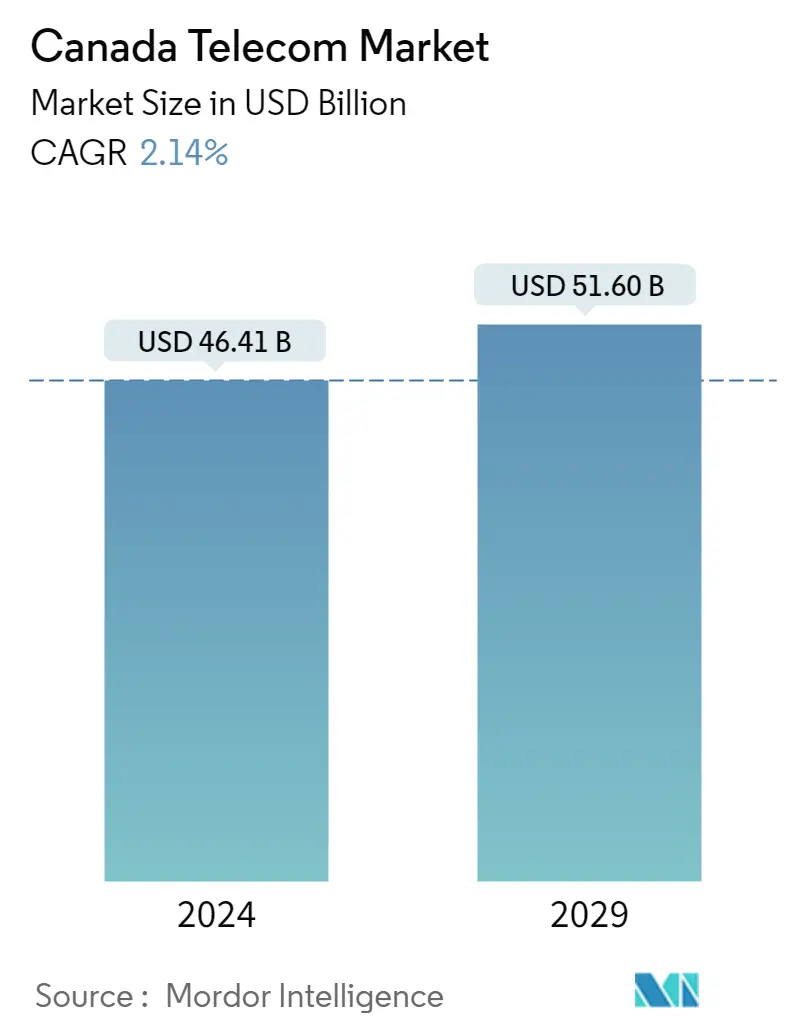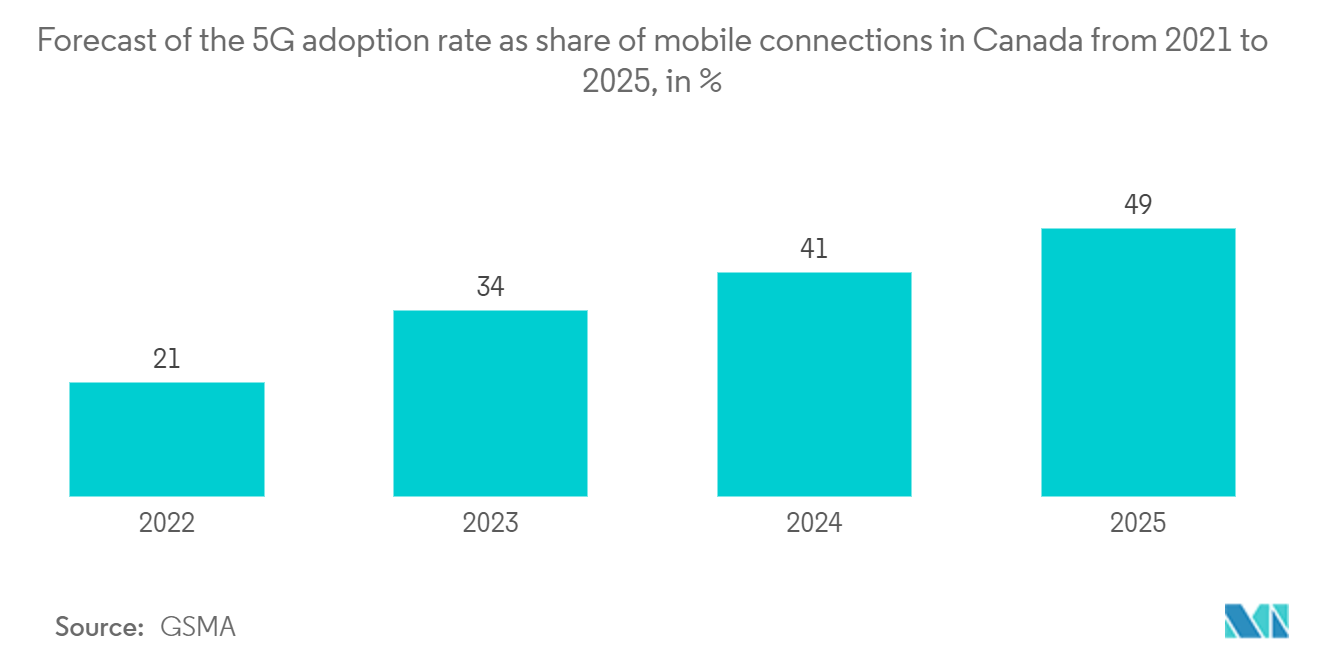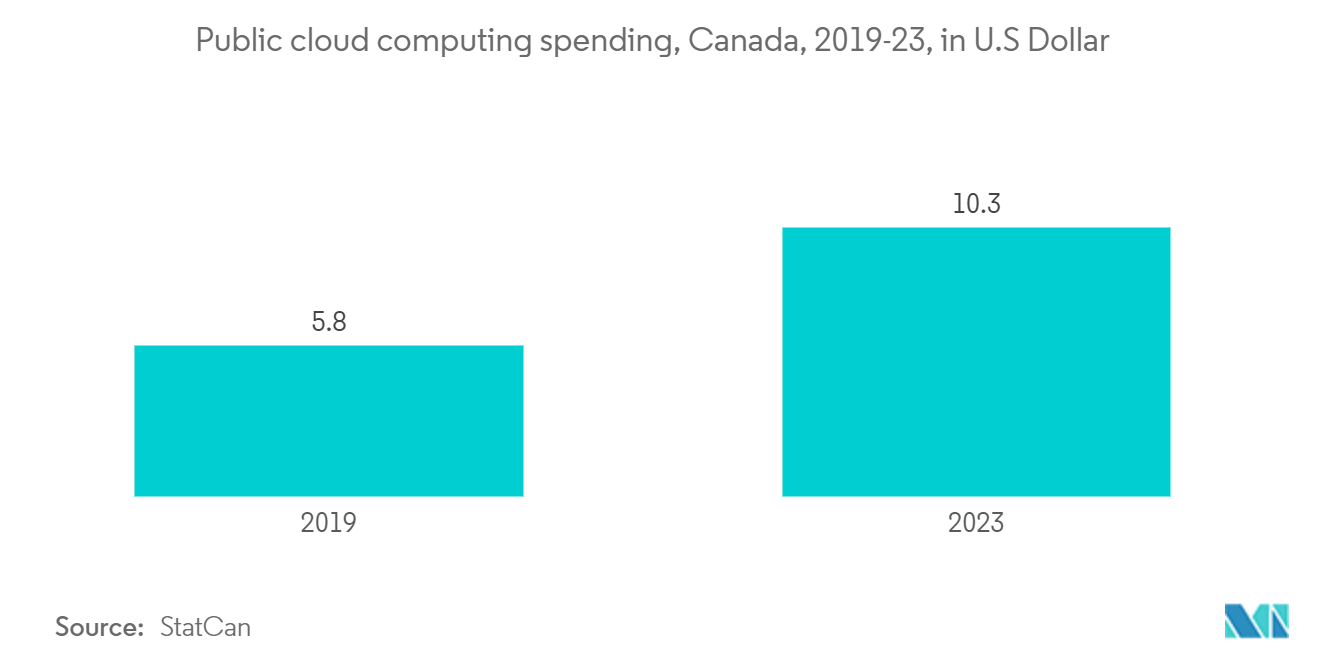Canada Telecom Market Size

| Study Period | 2019 - 2029 |
| Base Year For Estimation | 2023 |
| Market Size (2024) | USD 46.41 Billion |
| Market Size (2029) | USD 51.60 Billion |
| CAGR (2024 - 2029) | 2.14 % |
| Market Concentration | Low |
Major Players
*Disclaimer: Major Players sorted in no particular order |
Canada Telecom Market Analysis
The Canada Telecom Market size is estimated at USD 46.41 billion in 2024, and is expected to reach USD 51.60 billion by 2029, growing at a CAGR of 2.14% during the forecast period (2024-2029).
The Canadian telecoms sector experienced much activity in the last year. The telecom market witnessed various industry-friendly regulatory decisions in the first half of 2021. Furthermore, the telecom sector in Canada changed how people in the country interact with one another, conduct business, and have fun. It also fueled economic development and innovation and assisted in the fight against global warming.
- According to the Canadian Wireless Telecommunications Association (CWTA)/Accenture report, the introduction of 5G networks and services in Canada by 2026 will enhance GDP by an additional USD 40 billion and create 250,000 long-term jobs. It will also cost wireless carriers worth USD 26 billion. With significant expenditures made by Canadian facilities-based carriers, businesses that design and manage the country's top-notch wireless networks determine Canada's position as a global leader in wireless technology. Bell, Rogers, TELUS, Shaw/Freedom, Videotron, SaskTel, Eastlink, Xplore Mobile, and Tbaytel are examples of facilities-based carriers.
- Canada's facilities-based carriers put in place arguably the world's fastest and most dependable wireless networks, covering every province and territory, despite the country's population being dispersed across enormous areas. Canada is a "4G superpower," according to independent network analyst Opensignal, and there are few other countries that are better positioned than Canada to develop 5G networks of the future. According to a CWTA report, the full-fledged implementation of 5G in the country will support a thousand times traffic increase between 2020 and 2030.
- Canadian telecommunication services are used by other businesses to create and market goods and services. Thus, it significantly impacts the Canadian economy. Many industries, including the arts and transportation, saw significant income decreases due to the COVID-19 pandemic. Despite these market effects, telecommunications investments and infrastructure could accommodate new telecommunications connections that allowed all industries (other than telecoms) to contribute a total of USD 47.9 billion in direct GDP to Canada's economy in 2021. These telecommunication advantages were most noticeable in the fields of healthcare and education.
- The speed and coverage of Canada's top mobile wireless networks enable Canadians to use more wireless data. According to a CWTA projection, this growth will last for the foreseeable future. The average data usage per subscription with a data plan (GB/month) increased from 1.5 GB in 2026 to 5.3 GB in 2021. Encouragingly, the prices for these plans keep dropping as many customers move to better data plans. The price for 2GB data plans decreased by 41% in five years. Meanwhile, 5GB data plans dropped by 44% in five years, 10 GB plan dropped by 19% in two years, and 20 GB plans declined by 9% in one year. The price for the 50 GB plan also decreased by 26% in a year.
- The COVID-19 outbreak brought attention to how crucial connectivity is to Canadian society, commerce, and economy. With the continuous, accelerated growth in digital traffic, Canada's facilities-based operators continued to invest in expanding capacity and improving essential telecommunication services and infrastructure, laying the groundwork for a robust post-pandemic economic rebound. The telecommunications sector functioned in pace with the overall economy, keeping its percentage of the total Canadian GDP output. According to Accenture's analysis, the telecommunications sector's contribution to the GDP and the number of employments it supported might soon reach USD 70.7 billion and up to 596,000, respectively. The industry made more than USD 11 billion in growth and innovation of the infrastructure during this time. The shock of COVID-19 brought on a potentially long-lasting change in Canadian society and corporate operations.
Canada Telecom Market Trends
This section covers the major market trends shaping the Canada Telecom Market according to our research experts:
Accelerated 5G Rollout in the Country
- In Canada, the wireless sector is always evolving, and the launch of Fifth Generation (5G) networks will significantly develop. According to a recent analysis from Accenture, as 5G is implemented in use cases, cities and rural communities across Canada will experience tremendous economic and quality-of-life benefits, showcasing the impact it might have on the national level with the right support.
- As per a PWC report, by 2035, 5G is expected to enable an estimated USD 34 billion rise in GDP in Western Canada, with gains anticipated across all key industries. New use cases in the digital economy, including automated smart farming, connected and autonomous vehicles, and smart mining automation, will be made possible by 5G connectivity. These use cases will improve the use of inputs to reduce costs and provide opportunities to increase revenues through improved products and services. In Western Canada, the rollout of 5G is anticipated to have a large positive impact on the environment and society, including bridging the digital divide between urban and rural areas.
- By 2026, 5G wireless is predicted to add USD 40 billion to Canada's GDP, provide an additional 250,000 full-time employees, and increase consumer spending by 5%. Along with bridging the digital divide between urban and rural areas, 5G wireless technology will be crucial in aiding other industries in lowering greenhouse gas emissions. This is in accordance with the statements made by Robert Ghiz, President and CEO of the Canadian Wireless Telecommunications Association (CWTA), in his keynote speech at the May 2022 Wireless World Research Forum gathering.
- Adopting cutting-edge 5G enabled technology will allow other businesses to lower their carbon footprint. The utilization of mobile technologies, including 5G, across industries is predicted to have the ability to solve up to 23% of Canada's overall 2030 emission reduction targets, according to a report commissioned by CWTA. CWTA anticipates that the quick adoption of 5G would allow Canadian MNOs to reduce carbon emissions by up to 10 million tons between 2020 and 2030. The enhanced efficiency of 5G networks, which is fueled by improved data efficiency per unit of data transmitted, will primarily be responsible for this significant drop.
- The 3.5 GHz 5G service from the three Canadian carriers went live in June 2022, but there are already many expansion updates in the news. During the same time, Bell also confirmed that it would activate 3.5 GHz throughout southern Ontario, including Guelph, Kitchener, Waterloo, London, Barrie, and Mississauga. The new 3.5 GHz mid-band 5G represents a significant improvement over the prior 5G experience. Although most 2020-2021 5G rollouts added only a tiny amount of spectrum to the networks so they could be classified as 5G, this year's rollout doubles the number of airwaves used by carriers, enabling faster speeds and capacity.
- In June 2022, Telus noted the deployment of a 3,500 MHz spectrum will allow Montreal, Ottawa, Edmonton, and Victoria to enjoy a better 5G experience. The company added that the 3,500 MHz spectrum would also serve as the foundation for Telus' rural wireless high-speed internet service. Those residing in remote towns will have access to home internet rates of up to 100 Mbps, as it rolls out the 3,500 MHz spectrum across Canada. Telus intends to invest an additional USD 70 billion over the next four years in the spectrum, operations, and infrastructure to serve urban and rural clients.

More edge to cloud and IoT services
- Smartphones and other Internet of Things ("IoT") devices have changed the way life people across the country, and as more and more devices gain 5G capabilities coupled with our need for faster download speeds and undeterred signal strength, the auction for these coveted high-frequency licenses became much more critical to carriers all over Canada. Direct access to dependable cellular connectivity is essential for Canadian enterprises that are making innovations in the IoT arena. Six sections comprise Canada's telecommunications business, including local, long-distance, internet, wireless, data, and private lines, which are all relevant to building an IoT framework.
- The core of data-driven change is 5G innovation and edge computing. They will alter how everyone interacts and does business, including businesses, governments, and consumers, resulting in game-changing technologies and services. The Internet of Things and end-user connectivity are now available thanks to 5G, the next global cellular communications standard (IoT). It provides greater dependability, faster speeds, and more capacity. This opens the door for several further new use cases, including the widespread and cost-effective delivery of augmented and virtual reality over a multifunctional network with previously unheard-of flexibility, robotics, automated machines, increased factory automation, and many more.
- In early 2022, Bell Canada and Google Cloud together made the Canadian telco's network deployment of Google Distributed Cloud Edge. According to the firms, it is the first time essential network services have been implemented on Google Distributed Cloud Edge. Google Distributed Cloud Edge is a Google Cloud-managed service to operate 5G core and Radio Access Network (RAN) operations at the edge. It utilizes Anthos, a framework for managing applications and infrastructure provided by Google.
- As mega-corporations work to continue rolling out massive projects (Wireless Kiosks), like the one Bell Canada is implementing in Kingston, Ontario, IoT technologies are being studied and implemented gradually in Canada. Bell, a Canadian telecom firm, and Amazon Web Solution (AWS) Wavelength have developed a public multi-access edge computing (MEC) service to embed the latter's compute and storage service at the edge of Bell's 5G network. Since the previous three years, telecom and cloud corporations have collaborated often.
- The Canadian telecoms operator Telus and Google Cloud came into a 10-year strategic agreement in February 2021. Google and Telus will work together on brand-new services for a few important sectors. The agreement works on implementing Google's aim to grow new cloud operations in the telecom industry. The two businesses came to work together to develop fresh services and goods for several important sectors, including linked homes, agriculture, security, and healthcare. Telus also intends to use the Google Cloud Platform to update its own network and information technology.

Canada Telecom Industry Overview
The Canadian telecom market is highly fragmented in nature. Some major players in the market studied include BCE Inc., Telus Communications Inc., Shaw Communications Inc., Vidéotron, and Saskatchewan Telecommunications Holding Corporation. The market also hosts other Internet service providers (ISPs), MVNOs, and fixed-line service providers. Some Canadian telecom companies are competitive internationally and hold strong ground in the global market.
- In July 2022, Rogers Communications Inc. announced investing CAD 10 billion (USD 7.74 billion) over the next three years in artificial intelligence (AI), greater testing, and monitoring. This is just weeks after the business discovered network faults that resulted in widespread disruptions across the nation. Reportedly, to ensure that clients won't experience cellular and internet service interruptions, the company is physically isolating wireless and internet services to create an "always on" network.
- In April 2022, Bell announced that four new AMC Networks subscription video-on-demand services would be made available on Bell Fibe TV. Going forward, customers in Ontario, Québec, and the Atlantic provinces can subscribe to these services through Bell Fibe TV or the Fibe TV app and enjoy thousands of engaging TV series and movies on demand.
Canada Telecom Market Leaders
-
Rogers Communications Inc.
-
BCE Inc.
-
Telus Communications Inc.
-
Shaw Communications Inc.
-
Vidéotron
*Disclaimer: Major Players sorted in no particular order

Canada Telecom Market News
- In October 2022, Rogers Business unveiled the next stage of its strategic alliance with Microsoft for the first time in the world. After launching Operator Connect as the sole Canadian supplier last year, Rogers Business is the first operator to offer Canadians the newest hybrid work solutions from Microsoft. Critical solutions for Canadian organizations are expected to be delivered by the strength and performance of Rogers' 5G wireless network with Microsoft Azure's cloud architecture.
- In September 2022, Bell declared the availability of Bell Fibe Gigabit 8.0, giving consumers access to the fastest internet speeds in North America from the comfort of their homes. Bell's pure fiber Internet Gigabit 8.0 service, which offers symmetrical download and upload speeds of 8 Gbps, would now be accessible in Toronto's eligible areas. Bell's Giga Hub, which features the most recent Wi-Fi 6E technology, will also be available to consumers in Ontario and Québec.
Canada Telecom Market Report - Table of Contents
1. INTRODUCTION
- 1.1 Study Assumptions and Market Definition
- 1.2 Scope of the Study
2. RESEARCH METHODOLOGY
3. EXECUTIVE SUMMARY
4. MARKET INSIGHTS
- 4.1 Market Overview
- 4.2 Industry Ecosystem Analysis
-
4.3 Industry Attractiveness-Porter's Five Force Analysis
- 4.3.1 Bargaining Power of Suppliers
- 4.3.2 Bargaining Power of Consumers
- 4.3.3 Threat of New Entrants
- 4.3.4 Threat of Substitute Products
- 4.3.5 Intensity of Competitive Rivalry
- 4.4 Impact of COVID-19 on the Industry Ecosystem
- 4.5 Regulatory Landscape in the Country
5. MARKET DYNAMICS
-
5.1 Market Drivers
- 5.1.1 Emergence of 5G for Transforming Businesses
- 5.1.2 Market Leading Network Penetration
-
5.2 Market Restrain
- 5.2.1 Cut-throat Competition
-
5.3 Analysis of the Market based on Connectivity (Coverage to include In-depth Trend Analysis)
- 5.3.1 Fixed Network
- 5.3.1.1 Broadband (Cable modem, wireline-fiber, wireline DSL, fixed Wi-Fi ), Trends regarding ADSL/VDSL, FTTP/B, cable modem, FWA, and 5G FWA )
- 5.3.1.2 Narrowband
- 5.3.2 Mobile Network
- 5.3.2.1 Smartphone and Mobile Penetration
- 5.3.2.2 Mobile Broadband
- 5.3.2.3 2G, 3G, 4G and 5G connections
- 5.3.2.4 Smart Home IoT and M2M connections
- 5.4 Analysis of Telecom Towers (Coverage to include in-depth trend analysis of various types of towers, like, lattice, guyed, monopole, and stealth towers)
6. MARKET SEGMENTATION
-
6.1 Segmentation by Services (Coverage to include Average Revenue Per User for the overall Services segment, Market size and Estimates for each segment for the period of 2020-2027 and in-depth Trend Analysis)
- 6.1.1 Voice Services
- 6.1.1.1 Wired
- 6.1.1.2 Wireless
- 6.1.2 Data and Messaging Services (Coverage to include Internet & Handset Data packages, Package Discounts)
- 6.1.3 OTT and Pay-tv Services
7. COMPETITIVE LANDSCAPE
-
7.1 Company Profiles
- 7.1.1 Rogers Communications Inc.
- 7.1.2 BCE Inc.
- 7.1.3 Telus Communications Inc.
- 7.1.4 Shaw Communications Inc.
- 7.1.5 Videotron
- 7.1.6 Saskatchewan Telecommunications Holding Corporation
- 7.1.7 MeloTel Inc.
- 7.1.8 Quebecor Inc.
- 7.1.9 Cogeco Inc.
- 7.1.10 Telesat
- 7.1.11 Telecon
- *List Not Exhaustive
8. INVESTMENT ANALYSIS
9. MARKET OPPORTUNITIES AND FUTURE TRENDS
** Subject To AvailablityCanada Telecom Industry Segmentation
The study provides an in-depth analysis of the telecommunication industry in Canada. The Canadian telecom market is segmented by services, which is further classified into voice services (wired, wireless), data and messaging services, and OTT and pay TV.
| Segmentation by Services (Coverage to include Average Revenue Per User for the overall Services segment, Market size and Estimates for each segment for the period of 2020-2027 and in-depth Trend Analysis) | Voice Services | Wired |
| Wireless | ||
| Segmentation by Services (Coverage to include Average Revenue Per User for the overall Services segment, Market size and Estimates for each segment for the period of 2020-2027 and in-depth Trend Analysis) | Data and Messaging Services (Coverage to include Internet & Handset Data packages, Package Discounts) | |
| OTT and Pay-tv Services |
Canada Telecom Market Research FAQs
How big is the Canada Telecom Market?
The Canada Telecom Market size is expected to reach USD 46.41 billion in 2024 and grow at a CAGR of 2.14% to reach USD 51.60 billion by 2029.
What is the current Canada Telecom Market size?
In 2024, the Canada Telecom Market size is expected to reach USD 46.41 billion.
Who are the key players in Canada Telecom Market?
Rogers Communications Inc., BCE Inc., Telus Communications Inc., Shaw Communications Inc. and Vidéotron are the major companies operating in the Canada Telecom Market.
What years does this Canada Telecom Market cover, and what was the market size in 2023?
In 2023, the Canada Telecom Market size was estimated at USD 45.44 billion. The report covers the Canada Telecom Market historical market size for years: 2019, 2020, 2021, 2022 and 2023. The report also forecasts the Canada Telecom Market size for years: 2024, 2025, 2026, 2027, 2028 and 2029.
What are the emerging trends in the Canada Telecom Market?
The emerging trends in the Canada Telecom Market are a) Heightened focus on user data privacy regulations and consumer awareness of data security practices b) Demand for Personalized and Customized Services
Canadian Telecom Industry Report
The Canadian telecommunications market, marked by significant growth due to an increasing urban population and the widespread adoption of smartphones, is poised for further expansion. This growth is fueled by the adoption of Internet of Things (IoT) technologies and a swift transition towards 5G networks, anticipated to dominate mobile connections. Regulatory authorities play a pivotal role in this transition, essential for enabling technologies like autonomous cars. Despite facing challenges such as technical hurdles and public safety concerns, the competitive landscape remains highly consolidated with a few key players. These Canadian telecommunications companies are driving innovation and strategic investments, shifting towards value-added services to meet the demand for efficient communication. As the sector evolves, Canada telecom companies ensure the nation remains competitive in the global market, leveraging opportunities for growth and innovation. For detailed insights, Mordor Intelligence™ offers a comprehensive analysis of market share, size, and revenue growth, including a forecast outlook and historical overview of the Canadian Telecom market. Download a free report PDF sample for more information.



